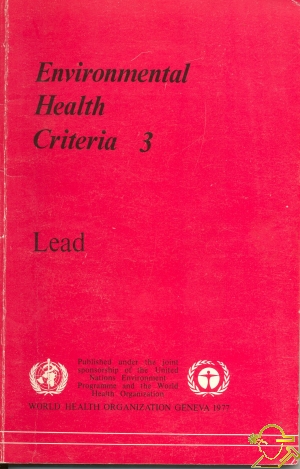Environmental Health Criteria 3
İÇİNDEKİLERCONTENTSENVIRONMENTAL HEALTH CRITERIA FOR LEAD 1. SUMMARY AND RECOMMENDATIONS FOR FURTHER RESEARCH . 1.1 Summary............................. 1.1.1 Analytical problems..................... 1.1.2 Sources and pathways of exposure............... 1.1.3 Metabolism......................... 1.1.4 Experimental studies on the effects of lead............ 1.1.5 Clinical and epidemiological studies on the effects of lead. Evaluation of health risk to man from exposure to lead............ 1.2 Recommendations for further research................ 1.2.1 Analytical methods...................... 1.2.2 Sources of lead intake..................... 1.2.3 Epidemiological studies.................... 1.2.4 Interactions of lead with other environmental factors....... 1.2.5 Significance of biological effects................ 2. PROPERTIES AND ANALYTICAL METHODS............. 2.1 Physical and chemical properties of lead and its compounds .... 2.2 Analytical procedures........................ 2.2.1 Sampling.......................... 2.2.2 Analytical methods for lead.................. 2.2.3 Methods for the measurement of some biochemical effects of lead 3. SOURCES OF LEAD IN THE ENVIRONMENT 3.1 Natural occurrence .1 Rocks................... .2 Soils.................... .3 Water.................... .4 Air..................... .5 Plants.................... .6 Environmental contamination from natural sources 3.2 Production of lead..................... 3.2.1 Lead mining..................... 3.2.2 Smelting and refining................. 3.2.3 Environmental pollution from production........ 3.3 Consumption and uses of lead and its compounds....... 3.3.1 Storage battery industry................ 3.3.2 Alkyllead fuel additives................ 3.3.3 Cable industry.................... 3.3.4 Chemical industry.................. 3.3.5 Miscellaneous.................... 3.3.6 Environmental pollution from consumption and uses of lead 3.4 Waste disposal....................... 3.5 Miscellaneous sources of environmental pollution........ 4. ENVIRONMENTAL TRANSPORT AND DISTRIBUTION .... 5. ENVIRONMENTAL LEVELS AND EXPOSURES............ 5.1 Exposure of the general population.................. 5.1.1 Air............................. - 5.1.2 Water............................ 5.1.3 Food............................ 5.1.4 Miscellaneous........................ 5.2 Exposure of infants and young children................ 5.2.1 Soil, dust, and paint..................... 5.2.2 Miscellaneous........................ 5.3 Occupational exposures....................... 5.3.1 Lead mining, smelting and refining............... 5.3.2 Electric storage battery manufacturing.............. 5.3.3 Shipbreaking and welding................... 5.3.4 Printing........................... 5.3.5 Alkyllead manufacture.................... 5.3.6 Other industrial exposures................... 5.4 Blood lead concentrations of various populations............ 5.4.1 Adult populations...................... 5.4.2 Children.......................... 6. METABOLISM OF LEAD....................... 6.1 Absorption............................ 6.1.1 Absorption by inhalation................... 6.1.1.1 Human studies.................... 6.1.1.2 The relationship of air lead to blood lead in the general population...................... 6.1.1.3 The relationship of air lead to blood lead in occupational exposure..................... 6.1.1.4 Animal studies.................. 6.1.2 Absorption of lead from the gastrointestinal tract....... 6.1.2.1 Human studies.................. 6.1.2.2 The relationship of oral intake of lead to blood lead levels in man...................... 6.1.2.3 Animal studies.................. 6.2 Distribution and retention.................... 6.2.1 Human studies...................... 6.2.2 Studies in animals.................... 6.3 Elimination of lead....................... 6.3.1 Human studies...................... 6.3.2 Animal studies...................... 6.4 The metabolism of alkyllead compounds.............. 7. EXPERIMENTAL STUDIES ON THE EFFECTS OF LEAD...... 7.1 Animal studies......................... 7.1.1 Haemopoietic system................... 7.1.2 Nervous system..................... 7.1.2.1 Inorganic lead.................. 7.1.2.2 Alkyllead compounds............... 7.1.3 Renal system...................... 7.1.4 Gastrointestinal tract................... 7.1.5 Cardiovascular system.................. 7.1.6 Respiratory system.................... 7.1.7 Reproductive system........... 7.1.8 Endocrine organs............. 7.1.9 Carcinogenicity............. 7.1.9.1 Inorganic lead compounds..... 7.1.9.2 Alkyllead compounds....... 7.1.10 Mutagenicity............... 7.1.11 Teratogenicity.............. 7.2 Acquisition of tolerance to lead......... 7.3 Factors influencing lead toxicity......... 7.3.1 Age and sex............... 7.3.2 Seasonal variations............ 7.3.3 Nutrition................ 7.3.4 Intercurrent disease, alcohol, and other metals 7.4 Human studies................. 8. EFFECTS OF LEAD ON MAN—EPIDEMIOLOGICAL AND CLINICAL STUDIES............................... 8.1 Retrospective studies of lead-exposed populations............ 8.1.1 Epidemiology of lead poisoning in industry........... 8.1.2 Epidemiology of lead poisoning in the general adult population 8.1.3 Epidemiology of lead poisoning in infants and young children 8.2 Clinical and epidemiological studies of the effects of lead on specific organs and systems.............................. 8.2.1 Haemopoietic system 8.2. 8.2. 8.2. 8.2. 8.2. 8.2. 8.2. .1 c5-aminolevulinic acid dehydratase (ALAD). . . . .2 Free erythrocyte porphyrins (FEP)....... .3 i5-aminolevulinic acid excretion in urine (ALA-U) . .4 Coproporphyrin excretion in urine (CP-U) .... .5 Effects of lead on cell morphology....... .6 Effects of lead on erythrocyte survival...... .7 Effects of lead on haem synthesis........ 1.8 Relationship between lead exposure and anaemia 8.2.2 Nervous system....................... 8.2.2.1 Central nervous system................ 8.2.2.2 Peripheral nervous system............... 8.2.3 Renal system........................ 8.2.4 Gastrointestinal tract..................... 8.2.5 Liver............................ 8.2.6 Cardiovascular system.................... 8.2.7 Reproduction........................ 8.2.8 Endocrine organs....................... 8.2.9 Carcinogenicity....................... 8.2.10 Effects on chromosomes.................... 8.2.11 Teratogenicity....................; 8.3 Factors influencing lead toxicity................... 8.3.1 Acquisition of tolerance to lead................ 8.3.2 Age............................ : 8.3.3 Seasonal variations...................... : 8.3.4 Nutrition.......................... ; 8.3.5 Intercurrent disease, alcohol, and other metals.......... ] 9. EVALUATION OF HEALTH RISKS TO MAN FROM EXPOSURE TO LEAD AND ITS COMPOUNDS........................1 9.1 Relative contributions of air, food, water and other exposures to total intake 1 9.1.1 Adult members of general population groups...........1 9.1.2 Infants and children..................... 9.1.3 Occupationally exposed population groups............ 9.2 Evaluation of haematological effects.............. 9.3 Dose-effect relationships................... 9.4 Dose-response relationships.................. 9.5 Diagnosis of lead poisoning and indices of exposure and/or effects for epidemiological studies.................... 9.5.1 Concentration of lead in blood (Pb-B)............. 9.5.2 Aminolevulinic acid dehydratase (ALAD)............ 9.5.3 Aminolevulinic acid (ALA) and coproporphyrin (CP) excretion in the urine............................ 9.5.4 Lead excretion in the urine.................. 9.5.5 Haematological changes (stippled cells, anaemia)......... 9.5.6 Lead in tissues (teeth and hair)................. 9.5.7 Some practical aspects.................... 9.5.7.1 General population studies............... 9.5.7.2 Occupationally-exposed persons............ 9.5.7.3 Reliability of the sampling and analytical methods 9.6 The problem of alkyllead compounds................. REFERENCES..............................    |



